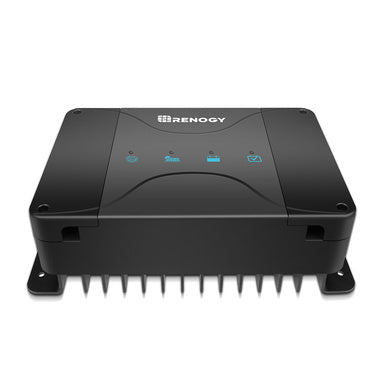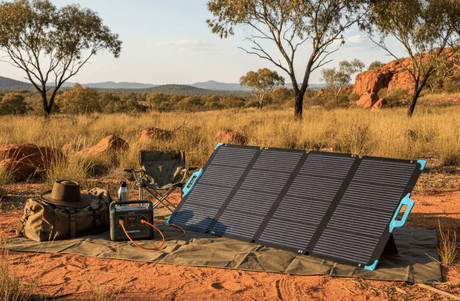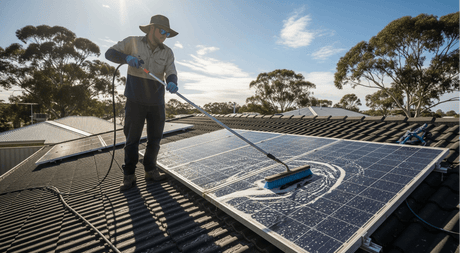A DC to DC battery charger can be a lifesaver for any Aussie who adventures across the bush or the coast. Not only can a DC to DC charger turn your vehicle into a source of power, but it can also allow you to enjoy an alternative to your solar panels on days that are a little bit more cloudy or rainy.
In this article, we’ll explore all of the things that DC to DC battery chargers can do, how they work with solar panels, and other essential details that you should know to optimize your battery management.
What Is a DC to DC Battery Charger?
DC to DC battery chargers enable users to charge the battery or batteries of their solar panel system with their vehicles. These devices ensure that your deep cycle batteries can charge adequately and achieve maximum capacity as efficiently as possible.
The charger does this by taking power from your vehicle’s alternator. In the past, this car component was actually known as a generator.
Normally, your vehicle’s alternator would be responsible for extracting power from the engine as a way to charge the built-in battery. However, when you connect a DC to DC battery charger to the alternator, it re-routes that power to your secondary batteries so that they can charge.
In a way, this process is similar to what happens when you use your car to jump-start another car that won’t turn on—you’re transferring energy from one source to another. Keep in mind that for all of this to work, your vehicle will have to be running.
If you use a dual battery setup for your solar panel kit, you will want to make sure your DC to DC battery charger comes with a solar regulator. That way, you will have the option to connect a solar panel directly to the charger. Consequently, you won’t have to purchase additional components for your dual battery system to work properly.
In the past, some people had concerns about DIY solar setups that used battery chargers that weren’t compatible with smart alternators. However, technological developments have advanced significantly. Now, a quality DC to DC battery charger has the intelligence to match your smart alternator, especially in a newer vehicle.
What Is an Onboard DC to DC Battery Charger?
If your motivation for purchasing a DC to DC battery charger is to take it with you on the road or in the water, you’ll want to explore your options for an onboard DC to DC battery charger. These devices allow you to leave your batteries charging in your vehicle or boat without leaving you to worry about them overcharging.
With an onboard DC to DC battery charger, an internal computer monitors the correct charging rate. Once the batteries have fully charged, the charging stops automatically. Not only can this prevent fire hazards or other safety issues, but it can also prolong the lifespan of your batteries, helping you to make the most of your investment.
How Do DC Chargers Work with Solar Panels?
So how do DC chargers work in conjunction with solar panels? In essence, when your solar panels cannot benefit from the presence of the sun to become fully charged, you can simply hook them up to your vehicle instead.
That can be particularly helpful for people that live in less sunny locations. If your solar panel system’s batteries have died in the face of multiple rainy or cloudy days in a row, you can still utilise your solar panels—you’ll just need to use your vehicle for the DC power source.
To do this, you will need to have two things in hand: A charge controller—which is a standard component of any solar panel setup—and a DC to DC battery charger. Without a DC to DC battery charger, there would be no way to properly transfer the energy from your vehicle to your solar panels.
The charge controller and charger work together to take the output from your vehicle and transform it to the proper amperage for your solar panel system. Usually, the correct amperage will be roughly 50 amps.
Some innovative DC to DC battery chargers can charge lead-acid and lithium batteries. That means that your charger can likely manage it regardless of the specific solar panel setup you have.
You can compare how a DC to DC battery charger works with your solar panels to the way that you charge your mobile phone every day.
Under normal day-to-day circumstances, your mobile phone’s battery provides it with the energy that it needs to operate. However, once that energy starts to run low, it’s time to plug it into a wall outlet to be charged.
The same is true when it comes to solar panels. Solar panels store their energy in batteries that provide you with the power that you need to operate your electronic devices. Once those batteries start to run low, you can hook them up to your vehicle using a DC to DC battery charger and get the power you need.
The DC to DC battery charger is like the charging cord of your mobile. Without it, you can’t restore a charge to your phone.
How Do You Hook Up a DC to DC Battery Charger to Your Solar Installation?
While you can use any vehicle with your DC to DC battery charger, there are some things to keep in mind, depending on the car that you use. For example, a DC to DC battery charge will work one way if you connect it with a standard car, but it may take special consideration to hook it up to an RV, tiny home, or boat.
The engine size of the vehicle that you use will also play a role in your expected charge time.
To set up your DC to DC battery charger with your vehicle, you will need to connect the charger to the vehicle’s power source at the fuse. Once the charger is connected properly, you can attach the solar panel directly to the battery charger or connect a secondary or auxiliary battery to the charger.
Suppose you are charging your system using an RV or a similar kind of large vehicle with a different electrical system. In that case, you may also need to purchase a 50-amp plug to connect the vehicle’s power to the battery charger.
If you don’t do this, the amount of energy that comes from your RV will likely overwhelm the charger, which could ultimately cause damage to your solar panel or your secondary batteries.
Always make sure to follow the manufacturer’s instructions for the DC to DC battery charger. Failure to do so could compromise your entire setup.
What Is the Function and Application of a 12V DC to DC Battery Charger?
The latest 12V compact-design DC to DC battery chargers can be a helpful solution when used in conjunction with solar power setups and boats, recreational vehicles, commercial vehicles, and other applications where portability is crucial.
Boats
If you have a boat or yacht docked in Sydney Harbour or the Whitsundays, adding a solar panel system with a DC to DC battery charger can help you avoid getting stranded in the South Pacific. Any avid boater knows a boat battery can die without warning. Of course, being left to float until someone comes along to help is less than ideal.
On top of having a backup battery charged and ready, you can also use your dual battery system to charge electronic devices. It can also give your stereo system some power or enable you to add a mini-fridge to your floating vehicle for your cold beverages.
Recreational Vehicles
An RV is likely the most common vehicle used to install a DC to DC battery charger because it contains various appliances that need a consistent power source. It’s also an ideal vehicle for a battery charger as it will see many kilometers, giving the battery charger sufficient energy to charge quickly from day to day.
With a dual battery system installed in your RV, you can arrive at campsites and not have to worry about finding the sunniest parking space or paying extra for a spot with an electric hook-up. However, it’s still a convenient option to consider.
If you happen to have a solar-powered generator, the additional portability opens up many opportunities to move about and still have the energy you need for electronic devices.
Commercial Vehicles
When it comes to commercial vehicles, a DC to DC battery charger works well for anyone who moves around with many power tools.
You can connect whatever tool you need to your extra battery and get your work done without as many restrictions. For example, if you’ve got a commercial vehicle for your mobile business, a battery charger, and extra battery means that you don’t have to end your workday early because you can’t find power.
A battery charger can also be helpful for road train drivers on long hauls. While they are driving their load to its final destination, they can charge their battery and have it ready for when they stop to rest. That means they can have their own power source onboard and can quickly charge their devices and run appliances like TVs, laptops, or tablets during their downtime.
Other Applications
With the new features and portable design of innovative DC to DC battery chargers, you can travel off-grid without having to worry about how to charge your solar panels along the way.
Whether you’re camping, supporting a mobile business, or heading out for a day on the lake, a DC to DC battery charger can set you up for success.
How to Find the Best DC to DC Battery Chargers
With so many types of batteries out there on the market today, including flooded, gel, AGM, and lithium batteries, it can be hard to know how well a specific DC to DC battery charger will work with the equipment you have.
A single 12V battery charger will provide enough energy for your system for most setups without overdoing it.
When you have a 12V DC to DC battery charger connected to your vehicle’s alternator, a single day of driving can charge your batteries roughly to full capacity.
In general, the best battery option will tend to be lithium, as these kinds of batteries are designed to avoid overcharging. This feature can help your battery to last longer.
Some of the best 12V DC to DC battery chargers out there on the market today have a range of features designed to make them more adaptable than ever before. With options designed to protect against overheating or overcharging, you can use these batteries in a wide range of situations.
Best of all, new battery chargers prevent voltage drops if they are hooked up with a long cable. This feature is beneficial when you’ll be charging from a vehicle, which may require a longer cord length.
Conclusion
Solar panels work with a wide array of applications, and they’re popular around the world. With more portable features now available in devices like DC to DC battery chargers, this solar energy can be harnessed in new and exciting ways while never leaving people stranded without the power they require.
A high-quality device like a DC to DC battery charger allows travelers to have a reliable backup option when the standard solar panel setup simply isn’t possible due to bad weather or other unforeseen circumstances. When you find a high-quality charger compatible with your system, you can make sure that you have the power you need, wherever you may go.
Initially, it might seem like a complicated process to choose a DC to DC battery charger that can complement your existing solar panel system; however, it is a lot easier than you might think.
With modern charging devices that work with your car, RV, or boat easily, you can harness the power of the sun while making sure that you have the energy you need to supplement your solar panel setup.






![What Is a DC to DC Battery Charger [Comprehensive Guide]](http://au.renogy.com/cdn/shop/articles/IMG_3829_bd86de74-31d6-49fd-b9d5-265bb723091d.jpg?v=1757582605&width=460)



